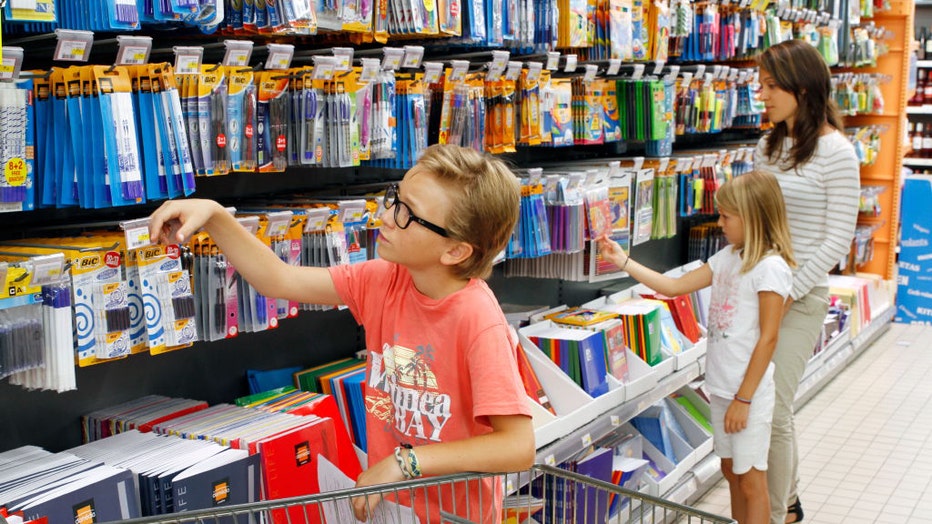Back-to-school shopping starts earlier as parents try to beat tariffs

Inflation rises in June as tariff pass-through begins
Adam Turnquist, Chief Technical Strategist at LPL Financial, joins LiveNOW's Austin Westfall to discuss the latest CPI report on inflation.
WASHINGTON - The back-to-school shopping season may start a little earlier this summer as parents try to get ahead of rising prices due to tariffs, according to a recent survey.
According to the National Retail Federation, two-thirds (67%) of back-to-school shoppers have already started going to stores.
The NRF said the head start is up from 55% last year and is the highest since NRF started tracking early shopping in 2018.
Additionally, 51% of back-to-school families are shopping earlier this year than last year, driven by worries that tariffs will cause prices to increase.
What they're saying:
"Consumers are being mindful of the potential impacts of tariffs and inflation on back-to-school items, and have turned to early shopping, discount stores and summer sales for savings on school essentials," NRF Vice President of Industry and Consumer Insights Katherine Cullen said in a news release. "As shoppers look for the best deals on clothes, notebooks and other school-related items, retailers are highly focused on affordability and making the shopping experience as seamless as possible."

Child getting School Supplies. (Photo by: BSIP/Universal Images Group via Getty Images)
By the numbers:
Though many consumers are starting their back-to-school shopping early, most (84%) still have at least half of their purchases left to make. The main reasons for this include waiting for the best deals (47%), not yet knowing what items they need (39%), and planning to spread out their spending over time (24%).
Stores and events such as Prime Day, Walmart Deals, and Target Circle Week remain popular opportunities for summer shoppers to tick off items from their back-to-school lists. In fact, 82% of shoppers are timing their purchases around these July sales specifically for the upcoming school year.
Families with students from elementary through high school plan to spend an average of $858.07 on clothing, shoes, school supplies, and electronics, down from $874.68 in 2024. Although overall budgets are slightly smaller this year, a higher number of consumers are buying apparel and electronics, pushing total expected spending to $39.4 billion, up from $38.8 billion last year.

CPI shows inflation ticked higher in June
The AIER's Lydia Mashburn Newman joins LiveNOW's Andrew Craft to help make sense of the latest inflation report.
K-12 families are budgeting an average of $295.81 on electronics (totaling $13.6 billion), $249.36 on clothing and accessories ($11.4 billion), $169.13 on shoes ($7.8 billion), and $143.77 on school supplies ($6.6 billion).
Online retailers remain the top choice for back-to-school shopping, with 55% of consumers turning to the web. Department stores (48%), discount stores (47%), and clothing stores (41%) also remain popular destinations.
College students and their families plan to spend an average of $1,325.85 this year, a slight drop from $1,364.75 in 2024. Despite the dip in per-person spending, more shoppers are making purchases across nearly every category, pushing total expected back-to-college spending to $88.8 billion—up from $86.6 billion last year.
The top spending categories for college include electronics ($309.50 on average, $20.7 billion total), dorm or apartment furnishings ($191.39, $12.8 billion), clothing and accessories ($166.07, $11.1 billion), food ($140.24, $9.4 billion), and personal care items ($117.95, $7.9 billion).
Inflation and tariffs
Dig deeper:
Inflation rose last month to its highest level since February as President Donald Trump’s sweeping tariffs push up the cost of everything from groceries and clothes to furniture and appliances.
Consumer prices rose 2.7% in June from a year earlier, the Labor Department said Tuesday, up from an annual increase of 2.4% in May. On a monthly basis, prices climbed 0.3% from May to June, after rising just 0.1% the previous month.
President Donald Trump has imposed sweeping duties of 10% on all imports plus 30% on goods from China. He has also threatened to slap 50% duties on Brazil, which would push up the cost of orange juice and coffee. Orange prices leaped 3.5% just from May to June, and are 3.4% higher than a year ago, the government said.
The Source: The Associated Press contributed to this report. The information in this story comes from a recent survey conducted by the National Retail Federation (NRF), which tracks consumer shopping trends. This story was reported from Los Angeles.

